Quantitative analysis of phthalate content
Phthalates are chemical compounds very often used in the polymer industry as plasticizers. They are dialkyl or alkylaryl esters of 1,2-benzenedicarboxylic acid. Their collective designation “phthalates” is derived from the trivial name for this acid, phthalic acid. In industry, we usually encounter the following:
- Bis (2-Ethylhexyl) phthalate (DEHP)
- Benzyl butyl phthalate (BBP)
- Dibutyl phthalate (DBP)
- Diisobutyl phthalate (DIBP)
- Di-isononyl phthalate (DINP)
- Di(isodecyl) phthalate (DIDP)
- Di(n-oktyl) phthalate (DNOP)
- Application description
- Infrared spectroscopy
Some basic additives in the production of plastics are referred to as plasticizers. These are substances that increase the plasticity (or directly the flowability) of the materials to which they are added, soften the final product, or increase its flexibility. To this day, phthalates can be found in hundreds of products commonly found in households around the world: children’s toys, cosmetics, shampoos, detergents, food packaging, adhesives, plastic pipes, medical devices, etc.
 However, phthalates are potentially dangerous substances, and many countries have been regulating and controlling their use for several years, especially for products that come into contact with children. Especially for plastic toys of various types. Phthalates are commonly used as plasticizers in PVC (polyvinyl chloride), but some of them can impair many vital functions and are being investigated as potential carcinogens, endocrine disruptors and are highly toxic to aquatic organisms.
However, phthalates are potentially dangerous substances, and many countries have been regulating and controlling their use for several years, especially for products that come into contact with children. Especially for plastic toys of various types. Phthalates are commonly used as plasticizers in PVC (polyvinyl chloride), but some of them can impair many vital functions and are being investigated as potential carcinogens, endocrine disruptors and are highly toxic to aquatic organisms.
Českými médii například nedávno proběhla informace o tom, že mezi dětmi velmi oblíbené gumičky na pletení barevných náramků mohou obsahovat zdravotně nebezpečná množství ftalátů. The European Union prohibits the sale of products in which the content of these dangerous substances exceeds the limit concentration of 0.1% by weight (see below), but some imitations from markets have exceeded these limits. In reality, phthalates are most often used in the concentration range of 3–30 weight percent, depending on the requirements for material properties. Phthalates in toys and children’s hygiene have been regulated in Europe since 2005 by the European Union Directive 2005/84 / EC, until 2009, when this directive was replaced by the EU chemical policy called REACH (Registration, Evaluation, Authorization and Restriction of CHemicals) . REACH limits the use of specified phthalates (DEHP, DBP and BBP) to 0.1 weight percent in all toys and products for children, in the case of DINP, DIDP, DnOP it even fully prohibits them in all products that can get into children’s mouths. On 31st March 2015, Directive 2011/65 / EU was signed in the EU, which specifies rules and restrictions for the use of hazardous substances in electrical and electronic equipment.
This directive, among other things, clearly specifies the maximum possible amount of selected phthalates in newly manufactured electrical and electronic equipment, namely 0.1% by weight for DEHP, BBP, DBP and DIBP phthalates, with effect from 22 June 2019. In other words, the manufacturer of electrical and electronic equipment must from 22nd of June 2019 declare the amount of phthalates used in their products.
 Compliance with these EU requirements can be very quickly introduced into production and quality control using the Fourier Transform Infrared spectroscopy technique (FT-IR, FT-IR). This method of molecular spectroscopy is a very fast screening tool for qualitative and quantitative analysis of phthalates in polymers.
Compliance with these EU requirements can be very quickly introduced into production and quality control using the Fourier Transform Infrared spectroscopy technique (FT-IR, FT-IR). This method of molecular spectroscopy is a very fast screening tool for qualitative and quantitative analysis of phthalates in polymers.
Infrared spectrometry as an optical non-destructive analytical method is a very suitable method for proving the presence of phthalates in plastics. Usually, it is sufficient to press the measured product on the ATR spectrometer adapter (ATR: Attenuated total reflection) and measure the infrared spectra, then remove the sample and measure again the “imprint” of this sample. By comparing the measured IR spectra with electronic databases of IR spectra, we obtain information about the identity of the given polymer, but very often also the plasticizer, lubricant or separator present. Such a procedure can be easily automated even for untrained operators in the form of a quick quality control of the product, including the presence of phthalates up to 0.1 weight percent.
The technique of measuring infrared spectra of polymers using the so-called ATR adapter does not allow a direct quantitative analysis of the content of phthalates in the product or the controlled sample. For this type of analysis, it is necessary to measure the polymer sample in an FTIR spectrometer using the classical transmission measurement technique. However, this operation already requires sample adjustment: forming a film with a defined thickness for quantitative analysis. For these purposes, we offer a universal polymer film maker for sample preparation.
The technique of forming foils from a sample to obtain its transmission infrared spectrum needs to be used only in the following cases:
- It is suspected that the content of phthalates in the sample is less than 0.1% by weight (situation unlikely in reality)
- Quantitative analysis of the phthalate content of the sample is required: the screening result obtained by the fast technique of the ATR attachment (without sample treatment) is not sufficient.
The company Nicolet CZ s.r.o. offers a package for polymer analysis, which includes a portable FT-IR spectrometer Nicolet iS5, ATR attachment, transmission attachment, accessories for creating KBr tablets and polymer films, libraries of high-resolution IR spectra (more than 13,000 spectra of polymers, additives, organic substances , inorganic substances, etc.), the possibility of automation of polymer analysis and of course a simple extension for other analysis techniques such as FTIR microscopy, combination with rheometry, TGA, GC, gel chromatography, etc.


